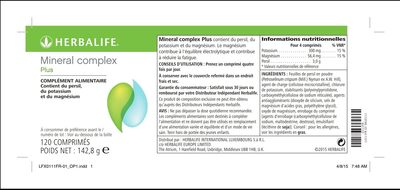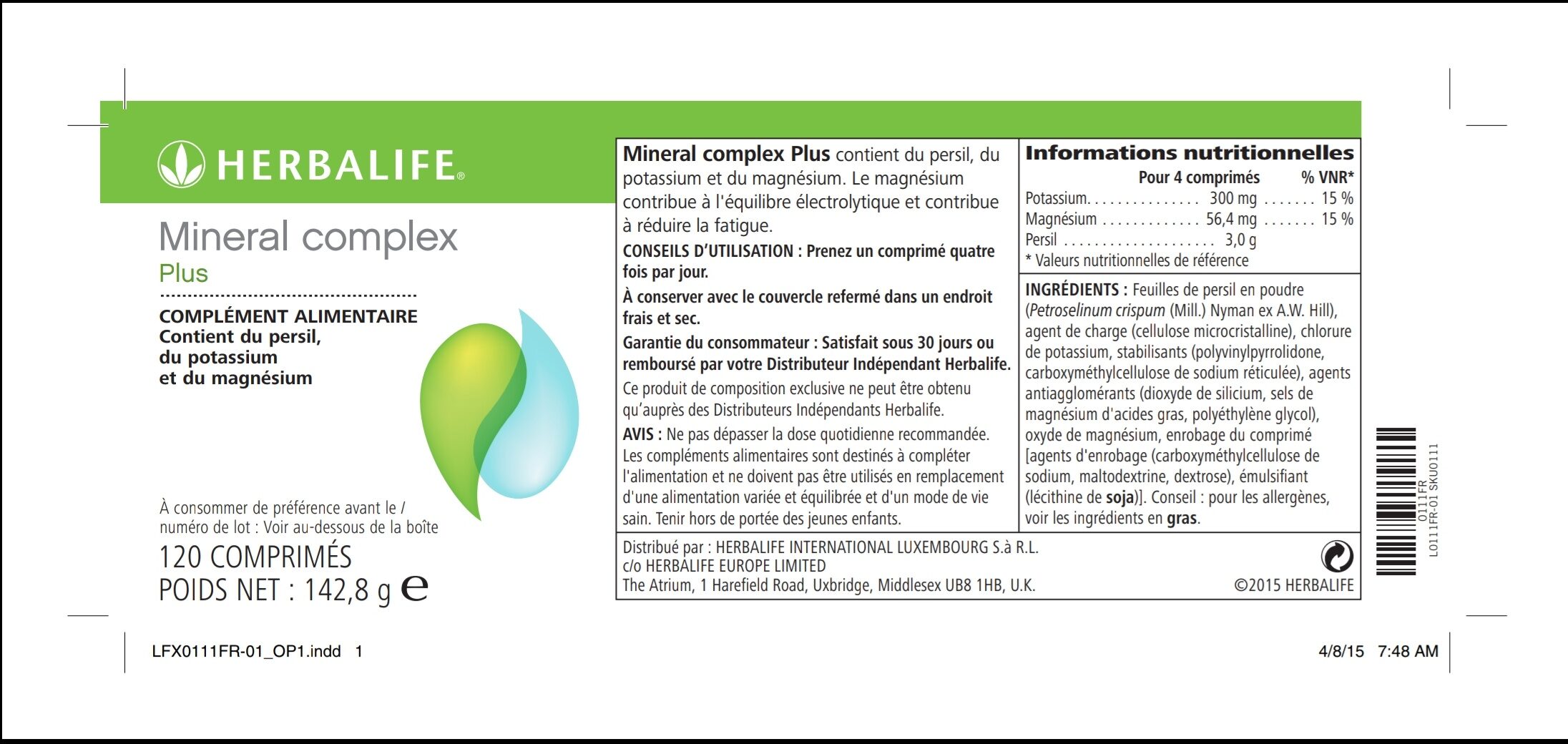Mineral complex Plus - Herbalife - 142,8g
This product page is not complete. You can help to complete it by editing it and adding more data from the photos we have, or by taking more photos using the app for Android or iPhone/iPad. Thank you!
×
Common name: COMPLÉMENT ALIMENTAIRE Contient du persil, du potassium et du magnésium
Quantity: 142,8g
Packaging: fr:Comprimés
Brands: Herbalife
Categories: Dietary supplements
Origin of ingredients: Europe, fr:Argentina - Español, fr:Armenia - Pyсский, fr:Aruba - Español, fr:Asia Pacific, fr:Australia - English, fr:Austria - Deutsch, fr:Azerbaijan - Русский, fr:Belarus - Pyсский, fr:Belgium - Français, fr:Belgium - Nederlands, fr:Bolivia - Español, fr:Bosnia i Hercegovina - Bosnian, fr:Botswana - English, fr:Brazil - Português, fr:Bulgaria - български, fr:Cambodia - English, fr:Cambodia - ភាសាខ្មែរ, fr:Canada - English, fr:Canada - Français, fr:Chile - Español, fr:China - 中文, fr:Colombia - Español, fr:Costa Rica - Español, fr:Croatia - Hrvatski, fr:Cyprus - Ελληνικά, fr:Czech Republic - Čeština, fr:Denmark - Dansk, fr:Ecuador - Español, fr:El Salvador - Español, fr:Estonia - Eesti, fr:Finland - Suomi, fr:France - Français, fr:Georgia - ქართული, fr:Germany - Deutsch, fr:Ghana - English, fr:Greece - Ελληνικά, fr:Guatemala - Español, fr:Honduras - Español, fr:Hong Kong - 粵語, fr:Hungary - Magyar, fr:Iceland - Íslenska, fr:India - English, fr:Indonesia - Bahasa Indonesia, fr:Ireland - English, fr:Israel - עברית, fr:Italy - Italiano, fr:Jamaica - English, fr:Japan - 日本語, fr:Kazakhstan - Pyсский, fr:Korea - 한국어, fr:Kyrgyzstan - Русский, fr:Latvia - Latviešu, fr:Lebanon - English, fr:Lesotho - English, fr:Lithuania - lietuvių, fr:Macau - 中文, fr:Malaysia - Bahasa Melayu, fr:Malaysia - English, fr:Malaysia - 中文, fr:Mexico - Español, fr:Middle East & Africa, fr:Moldova - Român, fr:Mongolia - Монгол хэл, fr:Namibia - English, fr:Netherlands - Nederlands, fr:New Zealand - English, fr:Nicaragua - Español, fr:North Macedonia - македонски јазик, fr:Norway - Norsk, fr:Panamá - Español, fr:Paraguay - Español, fr:Perú - Español, fr:Philippines - English, fr:Poland - Polski, fr:Portugal - Português, fr:Puerto Rico - Español, fr:República Dominicana - Español, fr:Romania - Română, fr:Russia - Русский, fr:Serbia - Srpski, fr:Singapore - English, fr:Slovak Republic - Slovenčina, fr:Slovenia - Slovene, fr:South Africa -English, fr:Spain - Español, fr:Swaziland - English, fr:Sweden - Svenska, fr:Switzerland - Deutsch, fr:Switzerland - Français, fr:Taiwan - 中文, fr:Thailand - ไทย, fr:Trinidad & Tobago - English, fr:Turkey - Türkçe, fr:Ukraine - Yкраї́нська, fr:United Kingdom - English, fr:United States - English, fr:United States - Español, fr:Uruguay - Español, fr:Venezuela - Español, fr:Vietnam - Tiếng Việt, fr:Zambia - English
Traceability code: CE
Matching with your preferences
Health
Ingredients
Food processing
Additives
Ingredients analysis
Nutrition
Environment
Packaging
Transportation
Report a problem
Data sources
Product added on by bricecrv45-gmail-com
Last edit of product page on by tacite-mass-editor.
Product page also edited by 1billion, 1billioncomsrls, 1billioncomsrls2, ecoscore-impact-estimator, foodonline, stephaniefood, stephanieincsellherbalife, thaialagata.




